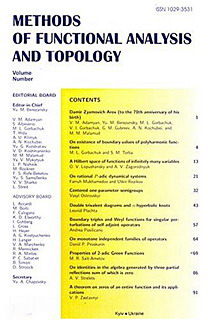Vol. 13 (2007), no. 2
Dedication [To the memory of Mark Krein on his 100th anniversary]
MFAT 13 (2007), no. 2, 101-102
101-102
Non-negative perturbations of non-negative self-adjoint operators
MFAT 13 (2007), no. 2, 103-109
103-109
Let $A$ be a non-negative self-adjoint operator in a Hilbert space $\mathcal{H}$ and $A_{0}$ be some densely defined closed restriction of $A_{0}$, $A_{0}\subseteq A eq A_{0}$. It is of interest to know whether $A$ is the unique non-negative self-adjoint extensions of $A_{0}$ in $\mathcal{H}$. We give a natural criterion that this is the case and if it fails, we describe all non-negative extensions of $A_{0}$. The obtained results are applied to investigation of non-negative singular point perturbations of the Laplace and poly-harmonic operators in $\mathbb{L}_{2}(\mathbf{R}_{n})$.
Inverse spectral problems for coupled oscillating systems: reconstruction from three spectra
S. Albeverio, R. Hryniv, Ya. Mykytyuk
MFAT 13 (2007), no. 2, 110-123
110-123
We study an inverse spectral problem for a compound oscillating system consisting of a singular string and $N$~masses joined by springs. The operator $A$ corresponding to this system acts in $L_2(0,1)\times C^N$ and is composed of a Sturm--Liouville operator in $L_2(0,1)$ with a distributional potential and a Jacobi matrix in~$C^N$ that are coupled in a special way. We solve the problem of reconstructing the system from three spectra---namely, from the spectrum of $A$ and the spectra of its decoupled parts. A complete description of possible spectra is given.
The investigation of a generalized moment problem associated with correlation measures
Yu. M. Berezansky, D. A. Mierzejewski
MFAT 13 (2007), no. 2, 124-151
124-151
The classical power moment problem can be viewed as a theory of spectral representations of a positive functional on some classical commutative algebra with involution. We generalize this approach to the case where the algebra is a special commutative algebra of functions on the space of multiple finite configurations.
If the above-mentioned functional is generated by a measure on the space of usual finite configurations then this measure is a correlation measure for a probability spectral measure on the space of infinite configurations. The latter measure is practically arbitrary, so that we have a connection between this complicated measure and its correlation measure defined on more simple objects that are finite configurations. The paper gives an answer to the following question: when this latter measure is a correlation measure for a complicated measure on infinite configurations? (Such measures are essential objects of statistical mechanics).
On stability and instability of small motions of hydrodynamical systems
MFAT 13 (2007), no. 2, 152-168
152-168
We give a short survey of an operator approach to some linear evolution and spectral problems of hydrodynamics: small motions and normal oscillations of a heavy or capillary fluid, a partially filled cavity in a moving or immovable vessel. The main attention is given to the problem of stability and instability of these hydromechanical systems with an infinite number of degrees of freedom.
$p$-Adic fractional differentiation operator with point interactions
MFAT 13 (2007), no. 2, 169-180
169-180
Finite rank point perturbations of the $p$-adic fractional differentiation operator $D^{\alpha}$ are studied. The main attention is paid to the description of operator realizations (in $L_2(\mathbb{Q}_p)$) of the heuristic expression $D^{\alpha}+\sum_{i,j=1}^{n}b_{ij}\delta_{x_i}$ in a form that is maximally adapted for the preservation of physically meaningful relations to the parameters $b_{ij}$ of the singular potential.
On $\mu$-scale invariant operators
K. A. Makarov, E. Tsekanovskii
MFAT 13 (2007), no. 2, 181-186
181-186
We introduce the concept of a $\mu$-scale invariant operator with respect to a unitary transformation in a separable complex Hilbert space. We show that if a nonnegative densely defined symmetric operator is $\mu$-scale invariant for some $\mu>0$, then both the Friedrichs and the Krein-von Neumann extensions of this operator are also $\mu$-scale invariant.
The square-transform of Hermite-Biehler functions. A geometric approach
Vyacheslav Pivovarchik, Harald Woracek
MFAT 13 (2007), no. 2, 187-200
187-200
We investigate the subclass of symmetric indefinite Hermite-Biehler functions which is obtained from positive definite Hermite-Biehler functions by means of the square-transform. It is known that functions of this class can be characterized in terms of location of their zeros. We give another, more elementary and geometric, proof of this result. The present proof employs a `shifting-of-zeros' perturbation method. We apply our results to obtain information on the eigenvalues of a concrete boundary value problems.


